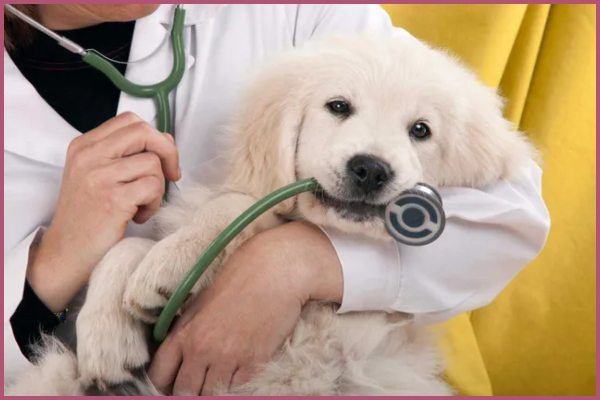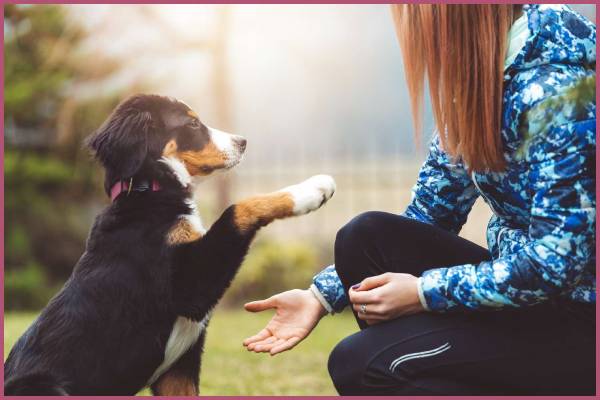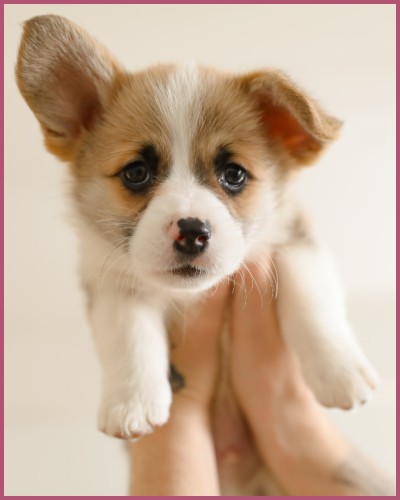9 Guides To Raise A Puppy!
- Everyone loves puppies because they’re cute but it takes a lot of time, effort, and patience to raise a puppy.
- Training puppies early on is vital.
- Puppies have different nutrition needs than an adult dog.
1. Puppy-proof your place
A puppy can wreck havoc on your home with all that energy, curiosity, and puppy mischief. When it comes to puppy care, it’s critical to puppy-proof its new habitat because its mind will view your home as an adventure playground.
First, relocate any potentially dangerous items, such as home plants, firmly out of his reach and secure electrical wires and cover cables, which could draw those razor-sharp puppy teeth.
Block off any rooms you don’t want your dog to enter as well as any areas that could be dangerous, including the stairs or big vents. If you find your puppy chewing anything other than the food you gave it, immediately remove it from its mouth.
2. Regular visits to the Vet’s
Booking an appointment with your veterinarian is one of the first things you should do when bringing a puppy home. This provides a vet the chance to examine your new puppy and look for any potential worms or parasites as well as any health issues.
You will be able to start a flea, tick, and worm program to keep your child parasite-free from this initial checkup. Establishing a vaccination program and scheduling your dog for neutering as soon as it is time are both crucial components of an initial visit to the veterinarian.
Spending some time with a veterinarian at the start of your pet-owning journey will offer you the opportunity to ask any questions you may have about how to raise a happy and healthy puppy.
After that, schedule a follow-up appointment six months later to assess your puppy’s growth.
Read more: Emma Roberts adopted a rescued dog, Chihuahua! The cutest addition to her family in 2023

3. Buying the necessary supplies
Here are a few essentials to help you satisfy the puppy’s wants. Here our puppy’s guide to his must-have goods is as follows:
- High-quality puppy foods and treats
- An ID collar
- A leash and a dog harness
- Poop bags and disinfectant
- A dog bed
- Grooming stuff such as a puppy-safe shampoo, nail trimmer, and toothbrush.
- Puppy-safe toys
Read more: Late Queen Elizabeth II’s Natural Love for Corgis Breed! Where are the Dogs now?
4. Feeding your puppy
Choose high-quality puppy food that has been specially prepared to aid in the growth and development of puppies. Age, size, and breed are among the variables that affect how much food to consume. It is recommended to free-feed puppies for some small breeds to make sure they get enough nutrition.
Toy and tiny breed dogs mature physically more quickly than larger breeds do, and between the ages of 9 and 12 months, they can start eating adult dog food and having adult-sized portions.
Larger breeds have different nutritional requirements than small breeds, and it can take them up to two years to reach physical maturity. They should consume puppy food designed especially for giant breeds.
The ideal time to transition your large breed dog to adult food should be discussed with your veterinarian. To avoid problems like stomach bloat, they should also be given many meals each day in manageable sizes.
- 6-12 weeks: 4 meals per day
- 3-6 months: 3 meals per day
- Over 6 months: 2 meals per day
5. Training your puppy
You should start house training as soon as possible. Set up a schedule for going potty while keeping in mind that small puppies often need to go out once every couple of hours. Be sure to give them a treat when they successfully poop outside.
It’s crucial to be patient with your pup as puppies don’t learn instantly. Never hit or yell at your dog; doing so will only make them confused, afraid, and uncomfortable.
You might tell them to chew on one of their toys if they are chewing on something they shouldn’t be. When they reach an appropriate age, think about enrolling them in an obedience course.
Also, read: Kim Kardashian Slammed by PETA and Animal Lovers for Keeping her Dogs in Garage!

6. Socializing your puppy
An important component of properly raising a puppy is proper socialization. They must be exposed to as many new people, places, experiences, and circumstances as they can to develop into properly behaved dogs.
While you should wait until your dog has received all of their shots before allowing them to interact with other animals or go out in public, you may start socializing your pup right away by playing with them and exposing them to new sights, sounds, smells, people, and other dogs.
7. Puppy Grooming
It will be much simpler for you if you begin grooming your dog when he or she is still a puppy. Trimmings, brushing their teeth, nail trimming, and bathing are all part of grooming.
You may certainly pay a professional groomer for haircuts or take your dog to the veterinarian for nail trimming, but you need to train your dog to remain still while you groom and make them pretty.
Giving your puppy baths can be a hassle in and of itself. Ease them with shampoo and water. This approach will get simpler as they begin to feel more at ease. Finally, although many pet owners find it unusual, brushing your dog’s teeth might help to protect their mouth.
8. Playing with your puppy
Puppies require care and exercise in addition to training and overall health. The good news is that this doesn’t necessarily entail going for brisk walks around the block, jogging around the neighborhood, or visiting the dog park. The exercise your puppy needs to stay healthy and strengthen your relationship with each other is frequently provided by playing with them.
To help them relieve any pent-up energy they may have from being at home alone all day, you can play activities like fetch, tug-of-war, and hide-and-seek with them. In addition to taking them for walks or letting them run about in your backyard, make sure to spend 30 to 60 minutes each day playing with them.

9. Arranging the puppy’s sleeping
After all that play and fun, puppies also require a lot of sleep. Even if it’s just to calm them down on their first night, try to resist letting your dog lie on your bed because it could soon turn into a habit.
If they are particularly uneasy the first few nights, it is acceptable to let them sleep in your bedroom, but make sure they have their sleeping area, ideally in a box.
Make their bed or kennel comfortable wherever you put it. Add soft pads, blankets, and their favorite toys.
You may also like to read: Travis Barker Honors his Late French Bulldog, Blue with an Emotional Tattoo!

